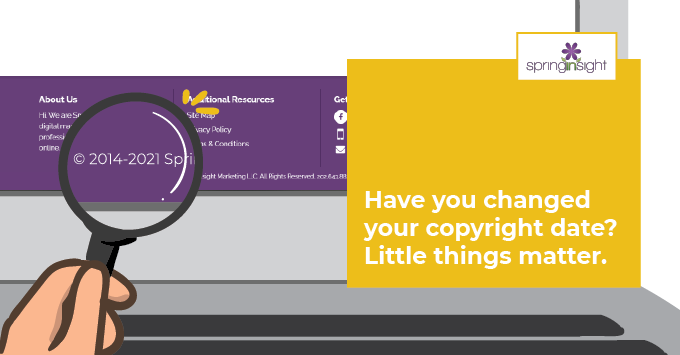
It All Matters
Have you ever watched the TV show The Wire? I won’t go on here about what a good show it is, many others have covered that territory. Recently, I was watching an episode and one of the characters, explaining his actions to another, said “It all matters. I know we thought it didn’t, but it does.” It is a profound scene.
Spoiler alert, nothing I write in this blog will be that profound. But, it struck me how true that statement really is. There are so many things that seem unimportant… but they are. Let’s talk about some little website items that matter.
Updated Copyright Date
When I look at a website, one of the first things I look at is whether the copyright date is current. To me, it is a clue about whether a website is being actively tended. (Since some sites automatically update, this isn’t a foolproof method.) When I am visiting a site in late January (or sometimes far later in the year) and I see that the copyright year is out of date, it is a good indication to me that the website isn’t a top priority for the company. No one is minding the little day-to-day things.
Favicon
Speaking of little things…let’s discuss the favicon, the little square icon that appears by your website name on the tab of your browser. It often gets overlooked when sites are built. Perhaps because it isn’t something that many people talk about (be honest, would you know what a favicon was if you hadn’t just read my description?). But, it matters. If you are like me and you keep a bunch of tabs open at a time, you know just how much it matters.
Broken Links
Here is the thing about links, you put them in a blog post without much thought about their future viability. Take the link I put above to the BBC article about The Wire. The article is there right now, but will it be there in a year, in three years, in five? Will the BBC do a site redesign that changes the domain structure?
You might be asking why it matters if a broken link is problematic five years after the blog was written. But it is. First, the whole reason you write a blog is to have your ideas exist for future consumption. If your content is good, people will look at it in the future. True story: our most popular blog most months is one that was written in 2016. Second, broken links aren’t ideal for SEO. (They aren’t the hugest deal, but it is better to avoid them.) So, how do you find broken links? If you google “broken link checkers” you will find a zillion. If you have a WordPress site, we like Link Monitor, a managewp product, quite a bit.
Outdated Blogs
Blog writing is a long term play. Often people get started with a lot of energy and, over time, that energy wanes and the blog goes stagnant. You have probably seen this… you go to a company’s blog and you see that the last blog post was in 2015.
Keeping a blog up to date is hard (Right at the moment, I would rather be streaming the next episode of The Wire than writing this). Bluntly, it isn’t for every company. So, a few suggestions on how to avoid an outdated blog. The most obvious suggestion, write a blog post on a schedule you can maintain (or hire a great team to do so). If it really isn’t something you want to engage in, hide your outdated blog. Or, if the content that is there is valuable and evergreen, have your developer take off the date so it doesn’t display.
Little things, all of these. None of them will keep you up at night. None of them require an emergency email to your web developer. But they matter. At Spring Insight, these are the kinds of everyday things that help our clients keep up-to- date.
I would love to share our approach with you and discuss how we work with our clients to make sure that every aspect of their website or their marketing matters. Let’s set up a time to talk.
